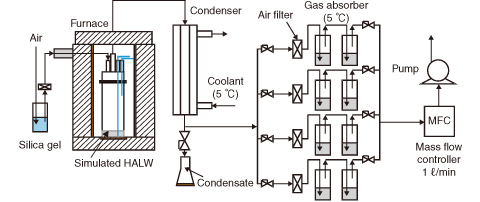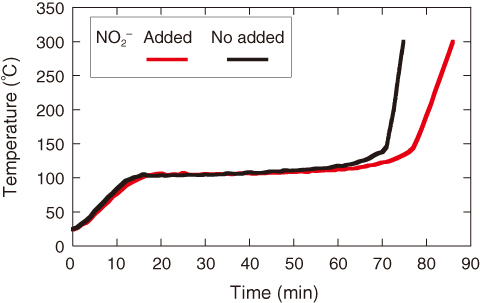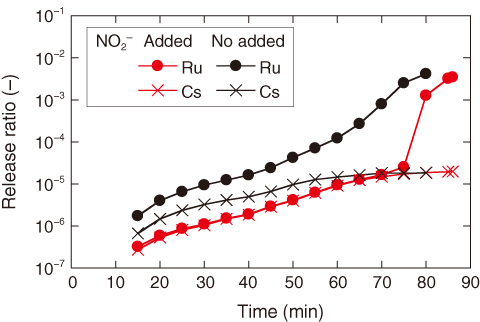
Fig.2-14 Apparatus to obtain release ratio of each element

Fig.2-15 Time dependence of sample temperature

Fig.2-16 Time dependence of release ratios
When the high active liquid waste (HALW) is no longer cooled, it may boil and dry out, and radioactive materials, which are dissolved in HALW, may be released in the air. Therefore, understanding the release and transport of these materials is necessary to evaluate safety issues in the case of an accident. This study simulates the release ratio of each element by virtually heating HALW, which was prepared using a stable isotope selected with reference to the composition of HALW. Fig.2-14 shows the apparatus used to obtain the release ratio. In the simulation, HALW was heated to 300 ℃ with the vapor flow rate being set equal to that estimated for an accident. Figs.2-15 and 2-16 show the time dependence of the temperature and the release ratio, respectively. The release ratio of ruthenium (Ru) rapidly increases beginning at the latter part of boiling step and continuing to the drying step. At 300 ℃, it increases to about 10-2. The release ratio of Ru is three orders of magnitude greater than that of nonvolatile elements, such as cesium (Cs). The release ratio of Ru appears to be greater than that of Cs because nitric acid is concentrated in the dried out HALW and concentrated nitric acid oxidizes nitrosyl Ru to create a volatile Ru species. However, in the boiling step, both Ru and Cs are considered to be present in the mist, which is generated by a bubble breaking in the boiling HALW. These elements are then released in the air. Fig.2-16 shows that the release ratio of Ru is greater than that of Cs at the boiling step without adding nitrite ions (NO2–) as the radiolysis product of nitric acid in HALW. Upon adding NO2–, the release ratio of Ru becomes the same as that of Cs. Consequently, NO2– is thought to prevent nitric acid from oxidizing nitrosyl Ru to create a volatile Ru species in HALW early in the boiling step.
The release data of each element were obtained in this simulation. In the next step of the simulation, we will obtain transportation data for each element released in the air and develop a model to analyze the release and transport due to a boiling accident.
The present study was accomplished in collaboration with Japan Nuclear Fuel Limited (JNFL) and the Japan Nuclear Energy Safety Organization (JNES).